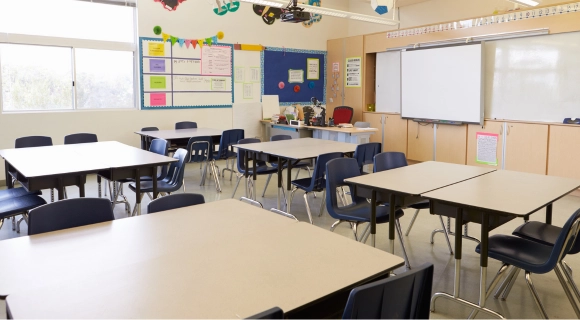Challenge
Many AC units do not respond to the BMS schedules, leading to indoor discomfort in the school due to high temperatures.
In recent months, the public school has experienced high temperatures in the classrooms because the AC units are not running when they should, leading to complaints from some students and teachers due to the elevated temperatures.
The HVAC units have been inspected several times by contractors, who have found failing components such as compressors and magnetic contactors. However, many times, the units are okay; they simply are not receiving the control signal to operate, which hints that there may be HVAC control issues involved. Our team was contacted to assist with this matter and cooperate with the contractor to identify the root cause of the underlying problems.

Scope of Work
Thorough examination of the public school’s building automation and HVAC control system. Identify root causes of issues, uncover malfunctioning and incomplete sequences of operations contributing to early equipment failure, and pinpoint critical and poorly commissioned components.
HVAC systems subject to the BAS and HVAC control audit:
- Twenty Unit Ventilators with Electric Reheat Coil and CO2 Sensors.
- Thirteen Single Duct Pressure Independent VAV Boxes with Electric Reheat Coil.
- Three Single Zone Constant Air Volume AHHs (DX – Coil).
- Two Multizone Air Handling Units with Chilled Water Coil.
- One Constant Water Flow Chiller Plant Composed of:
- One Air Cooled Chiller
- Two Chilled Water Pumps
Audit Summary
Total Equipment Audited
Incomplete Sequences Detected
Equipment Deterioration Factors
Energy Waste Sources Identified
Fault Detection Possibilities
Non-Commissioned Components
The school’s HVAC control issues are contributing to operational problems and component failures. Many HVAC control devices are offline, failing to follow the BMS occupancy schedules. Numerous sequences of operations are incomplete, and several components remain uncommissioned. The lack of commissioning and untested sequences has led to inefficient system operation and energy waste.
Critical Items
- The Air-Cooled Chiller runs continuously, resulting in significant energy waste.
- Both Chilled Water Pumps operate continuously, further contributing to energy waste.
- Three Air Handling Units run continuously, serving as another energy waste source.
- The entire Chiller Plant and two Multizone Air Handling Units have not been commissioned.
- Twelve Unit Ventilators are offline, unresponsive to BMS scheduling.
- Unit Ventilators’ CO2 sensors and electric heaters remain uncommissioned.
- Short cycling of Unit Ventilators’ compressors indicates early component failure.
- Compressor runtime balancing issues may lead to equipment lifecycle deterioration.
- Malfunctioning sequences of operations highlight the lack of commissioning at scale.
- All AHUs control valves require recommissioning for proper discharge air temperature control.
- Several other components, including CO2 sensors, control dampers, and blower status, need commissioning.
- AHUs and VAVs occupancy statuses mismatch, indicating incomplete operation synchrony.
- All operational points are fixed, leading to low performance and efficiency.
- Humidity control is absent, with no sensors monitoring space humidity in VAVs or AHUs.
- VAV boxes require zero calibration, heater recommissioning, and operation band adjustments for improved performance.
- Some VAV boxes are offline, lacking monitoring or control by the BMS.
- The BMS front-end user interface requires improvement, with many units displaying incorrect information and lacking trends, fault detection panels, and operational setpoints and bands.
Recommendations
- Address all identified energy waste sources and system inefficiencies to reduce HVAC power consumption.
- Recommission all units and critical components to ensure proper operation.
- Resolve short cycling compressor and runtime imbalances to prevent early component failures and extend equipment lifespans.
- Complete, test, and optimize all unit sequences of operations for improved performance and efficiency.
- Troubleshoot all offline devices to reintegrate them into the building automation network.
- Conduct an indoor air quality (IAQ) test and implement humidity control mechanisms for enhanced space comfort.
- Implement fault detection mechanisms to preempt potential future failures.
- Update the BMS user interface for improved visibility and operator control.
- Consider engaging a qualified commissioning agent to oversee and manage the implementation of these recommendations.


